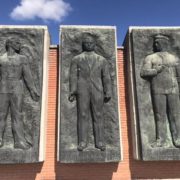Irredentism in Orban’s Hungary
By Timothy Li
One of the most memorable moments that I had while visiting Budapest was when looking at the flags on the Parliament building. While other countries that we have visited were adorned with European Union flags, the Hungarian Parliament building only displayed the national flag and strangely enough, the Szekelys’ flag. This is an extremely suspicious and provocative act since the Szekelys are an ethnic Hungarian minority that lives mainly in Central Romania. This provocation is rather suspicious since both Hungary and Romania are members of the European Union and NATO, making a real physical reclamation of Romanian land nearly impossible. But I believe that there are much deeper meanings behind the replacement of the European Union flag with the Szekely one.
Throughout our time in Budapest, we have been reminded about the Treaty of Trianon. This 1920 treaty mainly dealt with the division of the Kingdom of Hungary, at that time still legally a part of the dissolved Austria-Hungary. The division of the kingdom resulted in the new independent country of Hungary losing over 60% of its territory and 1/3 of ethnic Hungarians left as a diaspora in the new countries of Romania, Serbia, Czechoslovakia, and Croatia. This division became a source of great national trauma for the Hungarians, comparable to the experience of Germany and Russia post-World War I. The trauma left such an intense legacy for the Hungarians that the country made radical decisions such as an attempt to form a monarchic union with Romania and joining the Axis in World War II to reclaim the lost territories in the Carpathians and the Balkans. After the defeat during WWII, the Hungarian government did not succeed in achieving its goal of recreating its pre-WWI borders.
Although all sorts of nationalism seem to have been suppressed during the communist period, Hungarian irredentism was never truly wiped out. After years of communism and far-left ideology, many Eastern and Central Europeans today look to nationalistic parties, tradition, and the Catholic/Orthodox church first as “counter-culture’ and more recently, a reactionary movement to the liberal West. With the recent migrant crisis in Europe, Hungarians are even more passionate about the right-wing party of Fidesz. As an observer of Fidesz’s policies towards migrants, I was not surprised about the party’s conservative views on the Hungarian diaspora. However, I was shocked by the daring move of the Parliament to place the Szekely flag out in public in broad daylight. Not only is this threatening to the stability of Europe, it is also threatening from the point of view of NATO’s interests.
The problem with Fidesz’s irredentist perspective on Transylvania includes the inclusion of millions of ethnic Romanians into the expanded Hungarian state and historical revisionism. Since the Szekelys and other Hungarians live mainly in the Romanian counties of Harghita, Covasna, and Mures, also known as the Szekely Land, the Hungarian government will have to either take back all the pre-WWI Transylvanian territories, which will result in adding over 5 million ethnic Romanians into the country, or just take the Szekely Land, which will make Hungary’s borders extremely awkward due to the exclave within Central Romania.
In terms of historical revisionism, the Hungarian government seems to portray the Transylvanian region as a former “ethnically Hungarian” region that had been stolen by the Romanians, and was forced to undergo Romanianization. Even though the region of Transylvania was part of the Kingdom of Hungary for hundreds of years, the region has always been predominantly Romanian-speaking and Orthodox Christian. Even during Transylvania’s emergence as a feudal state in the 16th century, only a plurality of the population (particularly the nobility) were Hungarian, while the vast majority were Romanian serfs that were denied citizenship or civic rights. With the noncontiguous settlements of Hungarians in Transylvania, the existence of an independent Romanian state was bound to cause ethnic tensions between the two countries.
As a member of both the European Union and NATO, Hungary needs to differentiate between patriotism and irredentist nationalism. Given that the conservative government of Hungary right now does not want more immigrants due to its insecurity of the depletion of Hungarian traditions and culture (given a homogenous Hungary’s only recent existence in the 20th century), it surely does not want to take back all of its pre-WWI territories. That is unless, Orban plans to accept a multicultural state of Hungarians, Romanians, Slovaks, Croats, and Serbs who all speak unintelligible tongues, and Hungarians will once again return to living in a culturally pluralistic state.








